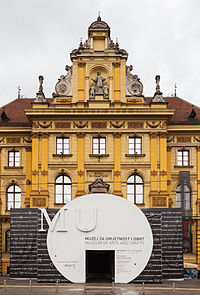Museum of Arts and Crafts, Zagreb
| Muzej za umjetnost i obrt | |

Entrance to museum
|
|
| Established | 1880 |
|---|---|
| Location |
Marshal Tito Square, Zagreb, Croatia |
| Coordinates | 45°48′33″N 15°58′07″E / 45.80917°N 15.96861°ECoordinates: 45°48′33″N 15°58′07″E / 45.80917°N 15.96861°E |
| Type | Arts and crafts |
| Collections | architecture, ceramics, clocks and watches, devotionalia, glass, graphic design, ivory, furniture, metal, musical instruments, painted leather, paintings, photographs and photographic equipment, photography up to 1950, printing and book binding, prints, product design, sculptures, textiles and fashion accessories, varia, Anka Gvozdanović's collection |
| Collection size | 100,000 |
| Founder | Izidor Kršnjavi |
| Director | Miroslav Gašparović |
| Website | muo |
The Museum of Arts and Crafts (Croatian: Muzej za umjetnost i obrt) in Zagreb, Croatia was established in 1880, by the initiative of the Arts Society and its former President Izidor Kršnjavi. Drawing on the theoretical precepts of the Endgland's Arts and Crafts movement and the intellectual postulates od Gottfried Semper, the museum was devised with the aim of creating a collection of models for master craftsmen and artist to reinvigorate the production of everyday use items. The strategy of the museum's activity was focused on presevation of traditional crafts, as well as creation of a new middle class aesthetic culture. Therefore, in 1882 the Crafts School (today Applied Art and Design School) was founded along the museum. The building, constructed in 1888 by Hermann Bollé, is one of the first purpose-built edifices devised to merge the functions of the museum and the school. Stylistically, the building is a grand Historicist palace in the spirit of the German Renaissance.
The initial holdings had been founded several years before the Museum was formally assembled. The first permanent display in its unsuitable premises opened in Gajeva Street 26, while the complete permanent display was first seen in its own venue in 1909. The current permanent display, open in 1995 according to the ideas of the former director Vladimir Maleković, and the spatial articulation of architect Marijan Hržić, includes chosen objects from all museum collections. The permanent exhibition extends over three floors at more than 2,000 m2 of museum space and includes about 3,000 exhibits. The displayed objects illustrate the shift of stylistic periods from Gothic to Art Deco.
The museum houses more than 160,000 objects spanning from 4th to 20th century. The initial holdings of the Museum had been founded several years before the museum was formally assembled. The first objects for the future museum were bought in 1875 by Izidor Kršnjavi with a donation of bishop Josip Juraj Strossmayer at an inheritance auction of Catalan painter and collector Mariano Fortuny in Paris.
...
Wikipedia
